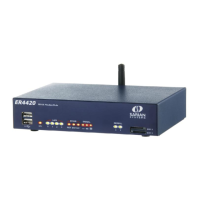Configure ISDN interfaces
Digi TransPort User Guide 246
Multiple Subscriber Numbers
An MSN (multiple subscriber number) is an alternative number provided by the telephone service
provider which when dialed will also route through to your ISDN line. It is possible to purchase
several MSNs for an ISDN line. This means that in effect one ISDN line can have several ISDN
numbers.
Every entity in the router which is capable of answering an ISDN call (Adapt, LABP and PPP) has
an MSN parameter.
A protocol entity’s MSN parameter can be used to:
• Cause a protocol instance not to answer an incoming ISDN call (if the trailing digits of the ISDN
number called do not match the entry in this field).
• Increase the answering priority of an instance (if more than one protocol instance is
configured to answer and the trailing digits of the ISDN number called match the value of the
MSN parameter for a particular protocol instance).
Example
Consider the following:
• An Adapt instance is bound to a serial port and ATS0 for that serial port is set to 1.
• PPP instance 0 has answering turned On.
• The ISDN line to which the router is connected has two numbers: the main number is 123456
and the MSN number is 123789.
Normally, because ADAPT has a higher answering priority than PPP, the Adapt instance will
answer when either of the numbers are called. However if the ISDN number dialed is 123456 and
456 is entered into the MSN parameter of PPP, PPP will answer instead. This will also have the
effect of preventing PPP from answering if any other ISDN number (such as 123457) has been
called.
This means that whenever 123456 is called the PPP instance will answer, and whenever 123789 is
called, the V120 instance will answer.
It is possible to connect multiple ISDN devices to the same ISDN line. MSNs can then be used to
allow the different ISDN devices to be dialed individually (such as dial the main ISDN number),
and get through to ISDN device one, dial the first MSN and get through to ISDN device number
two, dial the second MSN, and get through to ISDN device number three, etc.).

